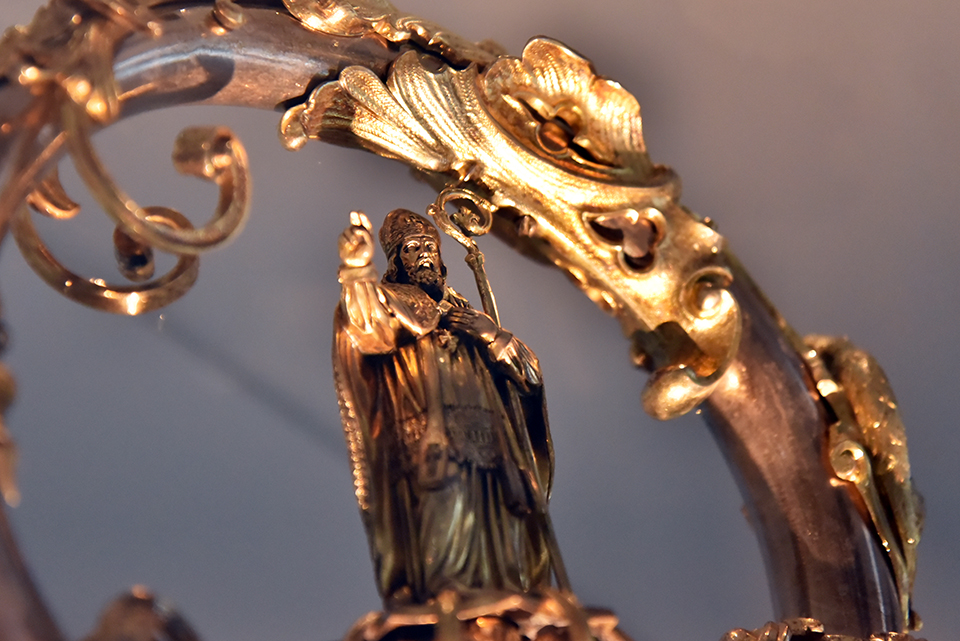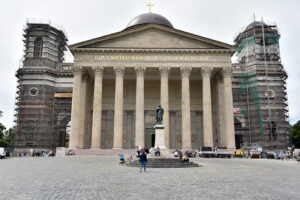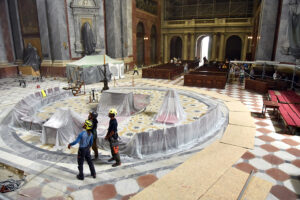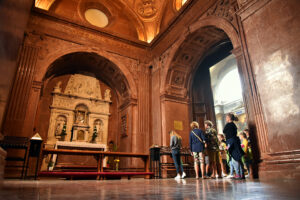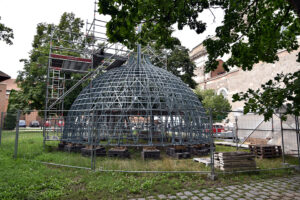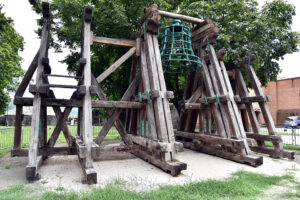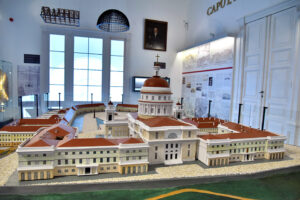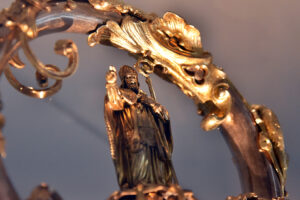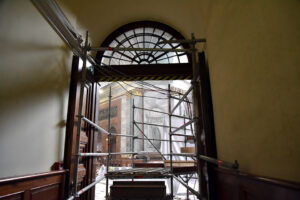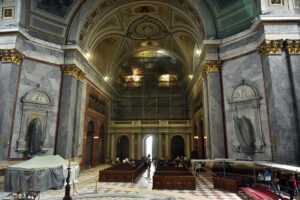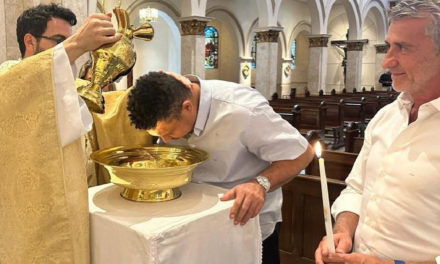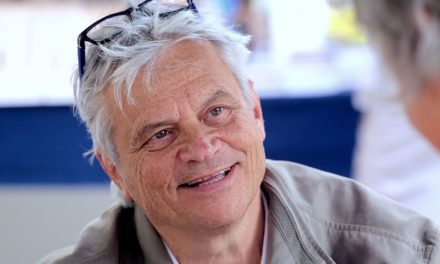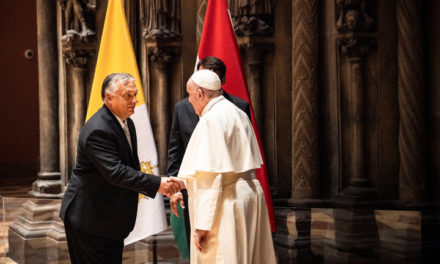A church has stood on Várhegy in Esztergom for more than a thousand years. The first was founded by Prince Géza, and his son Szent István was baptized there. Over the centuries, several churches were built on the mountain, until the basilica we know today was built. We visited the sixth year of the renovation of the Cathedral of Our Lady and Saint Adalbert, or, as most people know it, the Basilica of Esztergom.
Written by: Tamás Császár
The first known Christian church in the area of Várhegy in Esztergom was founded by headman Géza, says the opening table of a new building history exhibition that recently opened on the first floor of the Esztergom Basilica. Why is this important? The founding king of our state, Szent István, was baptized, confirmed and married in this church, and according to some sources, he was crowned here.
The predecessor of today's Basilica, the St. Adalbert Cathedral, was later built next to it. A part of the building, which bears the characteristics of romance, gothic and renaissance, can still be seen today:
the Bakócz chapel built in 1508, which was also housed in the 19th century (current) building.
The chapel made of two types of marble is our best-preserved renaissance monument. We will return to the chapel later.
After the Turks occupied Esztergom in 1543, the church was neglected, and by the time the city was liberated in 1683, the building was already in ruins. In the 18th century, during the time of Archbishop Ferenc Barkóczy, new plans were made in the Baroque spirit, the old building was demolished, leaving only the Bakócz Chapel. The implementation of the grand plans ended with the death of the archbishop, and only a more modest church was built.
In the 19th century, Archbishop Sándor Rudnay initiated the construction of a grandiose church center, a model of which can also be seen in the exhibition.
The foundation stone of the new building was laid on April 23, 1822, and it was put into use in 1856, although many work processes continued in the building for a long time.
The ongoing renovation of Hungary's largest basilica, an important classicist monument, began in 2018, during which the eastern facade was renovated, and the renovation of the dome's structure and the replacement of its copper plates were completed. The western roof and the part of the roof above the eaves are being renovated, which tourists participating in the dome tour can follow. It is true that anyone who wants a similar experience will have to take a tough hike, as there are more than 400 steps leading up to the dome. There, where the renovation is slowly being completed: the copper plates of the outer dome have already been replaced, and the huge golden cross shines on the top of the building.
The "floating" scaffolding (whose square-based, load-bearing steel frame was built at ground level and raised to the ledge of the dome) is slowly dismantled, so you can see the decorations and gilding of the dome's interior not only in the image printed on molino, but also with your own eyes.
And whoever looks up will be in for a real miracle, because after years of work by Italian restorers, the entire interior has been reborn and is more colorful than ever.
The scaffolding is planned to be removed by the end of the year.
However, the stand and bridge in front of the sanctuary were already demolished on August 15, so the festive mass could be held in more orderly conditions. For this, the paving of the sanctuary had to be completed. The replacement/renovation of the floor of the sanctuary is almost completely finished, when we were there the specialists were only working on small islands. By the way, the paving is essentially the same age as the construction of the basilica; in an arrangement similar to a chessboard, the red tiles are cut from Süttő limestone, the white ones from Carrara marble, and they are connected by gray slate. After this work, there will no longer be significant work involving dust and noise in the church square, and from the end of the year, intimate silence will once again reign in the basilica. After the demolition of the protective roof and footbridge in front of the sanctuary, the protective roof will soon be transferred to the northern side, where major works, the renovation of the paving, are currently underway.
It would be useless to look for the organ in the gallery, because it was demolished last year in order to renovate the grandiose instrument. The restoration of the painting in the gallery and the gilding of the wall decorations have begun, the work being carried out by the same Italian specialists who have restored the dome so far.
The organ can only be returned after finishing the works involving dust, as the instrument is extremely sensitive. The organ cabinet will be built first, followed by the pipes, which will be renovated in Pécs. At the same time, the tuning and intonation of the whistles is a lengthy process, since this task has to be performed with thousands of whistles. "It is expected that the work will take place at night, as it is a time-consuming and rather noisy task that visitors would find difficult," we learn from Péter Rokolya, cultural and tourism manager of the Cathedral of Our Lady and Saint Adalbert in Esztergom.
Walking out of the building and facing the basilica, you can see that work is being done on both towers. According to the preliminary plans, the contractor should complete the renovation of the two parts of the building this year.
The bells were in the southern tower (which stands on the side facing the castle), and in order to renovate the bells and the wooden, metal-reinforced belfry as easily as possible, it was easier to remove the entire dome, which was preserved on the square level. Along with the belfry (which, like the floor, is also an original element of the building), tourists now take pictures of the two parts of the building - they offer an unusual sight while resting in the grass! The dome of the northern tower did not have to be removed, because there are no bells, so only the copper plate covering was removed, the frame was surface treated, and the copper plates were then replaced.
In parallel with the external works, the two towers are also being renovated internally: offices and changing rooms are being created in the upstairs rooms in the northern tower. The southern tower, where the ticket office and the gift shop currently operate on the ground floor, and the museum teaching room on the first floor, will also be renovated in the near future.
After the renovation, in addition to the facade, the towers will also regain their old splendor, their building stones will be completely cleaned and bathed in sunlight. The possible replacement of the evening decorative lighting has not yet been decided, according to Péter Rokolya, it will be one of the tasks of the near future. The complete renovation of the basilica will take approximately five years and will cost approximately HUF ten billion.
The restoration of the building entails burdens both for the visitors and the faithful, as well as for those who work there, however, the liturgical life did not stop, and not all spaces were closed to visitor traffic at the same time, Péter Rokolya points out. They tried to come up with programs that would be interesting and possibly add value to the visitors. He says that the current phase was the most difficult, since the several simultaneous works involved many inconveniences, and the building did not show its most beautiful face.
Compared to the usual ones, this period was a big burden for them, because the interior of the basilica is quiet and clean in a different milieu than when there are noisy and dusty works going on in the interior, which also hinders traffic in the building.
"However, the treasury remains beautiful and can be visited continuously. Opposite it, we also had the strength to open a small building history exhibition"
- Péter Rokolya shows the mini-exhibition opposite the treasury, after we walk up to the first floor together again.
However, the renovation creates a new situation in the future and offers new opportunities, says the tourism expert. New visitor routes will be created: in order to avoid tumult, one-way routes will be created, meaning that visitors will not leave the building where they enter. It is also possible that those who go to a certain part of the building with a predetermined goal, such as the treasury, the cafe or the dome, do not have to go the same way as those who want to take part in a full church tour.
The "tourist life" in the Basilica will also change, as they will be able to use the church square more and in a larger area than before.
"Once the renovated organ is back, an incredible opportunity will open up for us, we have to plan regular music programs for this opportunity, that's not even a question!
In addition, we want to fill the Bakócz Chapel with content in such a way that it is even more interesting and special, so we will also want to make its sacristy open to visitors and enrich the visitors with a musical experience several times a day by playing the works of the Bakócz Graduále (the Bakócz Graduále is a two-volume renaissance codex containing hymns - ed.). We are in the process of creating a free application available in Hungarian, Slovak, English and German, which will provide free information to all visitors in the church square. Let's give a little more to the visitors, let's serve them if they have already honored us by visiting us!"
– Péter Rokolya lists the tasks for the coming period.
- Photo: Tamás Császár/Civilek.Info
- Photo: Tamás Császár/Civilek.Info
- Photo: Tamás Császár/Civilek.Info
- Photo: Tamás Császár/Civilek.Info
- Photo: Tamás Császár/Civilek.Info
- Photo: Tamás Császár/Civilek.Info
- Photo: Tamás Császár/Civilek.Info
- Photo: Tamás Császár/Civilek.Info
- Photo: Tamás Császár/Civilek.Info
- Photo: Tamás Császár/Civilek.Info

